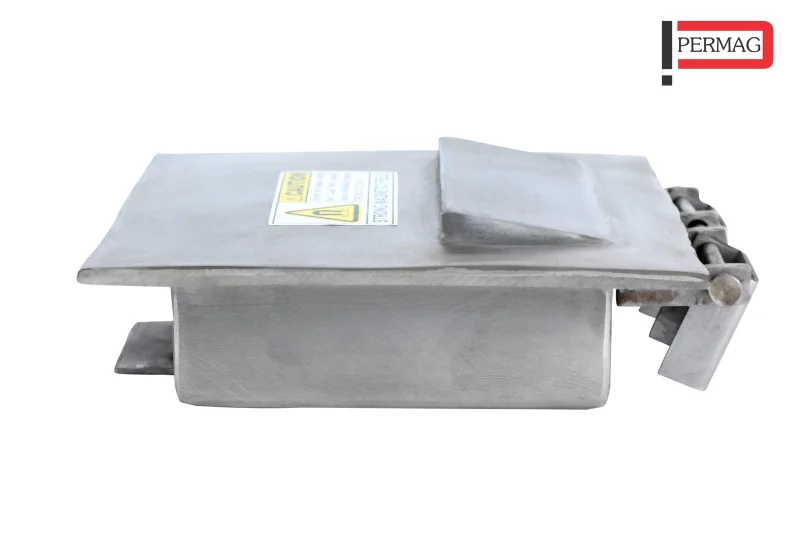Plate magnet is designed to effectively capture undesirable ferrous metals from the final product. This is particularly useful in situations where the use of magnetic tubes or grates may impede the flow of the product or cause premature wear and tear on the tubes. Plate magnets have the capability to be strategically positioned in chutes, above conveyor belts, and beneath conveyor driving pulleys.
Magnetic Plate hold significant importance in industrial settings as they serve as iron separators, specifically designed for the separation of fine ferrous materials and tramp iron. These plates are utilized in many applications including the separation of free-flowing and pneumatically delivered materials, as well as granular substances. Flat, thin magnets find utility in a diverse range of applications.
Plate magnet are highly compatible with powdery, damp, lumpy, and abrasive substances, as well as with huge debris that has the potential to obstruct, form a bridge, or accelerate deterioration in separators based on cartridges. Plate magnets possess the necessary flexibility to be strategically positioned either above conveyors or beneath conveyor driving pulleys, so effectively capturing pollutants. These devices are offered in both flat and curved configurations and can be positioned either above or at the discharge terminus of material flow.
Features of Magnetic Plate
- Efficient and cost-effective recovery of potentially hazardous tramp iron in materials that are free-flowing.
- Plate magnets can be installed either above or below the product flow, depending on the application.
- Plates typically utilize ceramic or rare earth magnets as a source of magnetic attraction.
- Magnetic separators are able to collect the greatest amount of typical ferrous trash.
- Constructed entirely of corrosion-resistant stainless steel.
- Swinging out hanging plates allows for simple removal and cleaning.
- Manual cleaning of the Plate Magnets is an additional option.
- Easy to set up and require little to no maintenance once installed.
- Easy to carry about and not too heavy.
- Designed to pick up metal debris from floors and other surfaces.
- Consists of a heavy-duty frame with one or more magnetic bars or plates attached to the bottom.
- The magnetic bars or plates create a magnetic field that attracts any metallic particles in their path, such as nails, screws, or metal particles.
- The collected metal is then held in place by the magnet until it can be released manually.
They are also used for separating trapped iron in industries such as Food, Pharmaceuticals, Chemical, Automobile, Sugar, Plastic and many more.
How Does it Work?
The process by which a magnetic plate removes ferrous impurities from material flows can be divided into several main steps:
Strong Magnetic Force
The magnetic force field generated by the magnetic plate used in this procedure is quite strong. The magnetic force acting on the ferrous impurities inside the material flow is, critically, orders of magnitude stronger than the forces of gravity and inertia. Small bits of iron or steel are examples of these pollutants.
Magnetic Field Creation
The magnets on the magnetic plate generate a powerful and concentrated magnetic field around the plate as the substance containing ferrous impurities flows over or passes near the plate. The process’s success in attracting and collecting ferrous particles is due to the presence of a magnetic field.
Attraction of Ferrous Material
Magnetism is an innate property of materials that have ferrous contamination. These ferrous impurities are attracted to the plate by the magnetic field created by the magnets when they come into contact with it. Because their intrinsic magnetic moments coincide with the direction of the external magnetic field, ferrous materials are drawn to it.
Collection and Magnetization
As the fluid carrying the ferrous pollutants flows over the magnetic plate, the strong magnetic field attracts and magnetizes the contaminants. This means that the magnetic plate’s field causes the ferrous particles to take on a magnetic character of their own. The plate is more likely to capture magnetized particles.
Accumulation
Ferrous pollutants, having been magnetized, are attracted to the plate and begin to accumulate there. Many variables affect how quickly and how much pollution is collected. These factors include the size and concentration of ferrous impurities in the material, the flow rate of the material over the plate, and the strength of the magnetic field generated by the plate.
Variables’ Impact
Keep in mind that these variables can have a noticeable impact on the magnetic plate’s performance. Increases in magnetic field strength allow for greater pollution capture, while variations in material flow may change how long pollutants remain in close proximity to the plate. The size and concentration of ferrous contaminants in the material will also effect capture and accumulation on the plate.
Permag Products for Plate Magnet
A plate magnet can be used to filter out ferrous contaminants from a wide range of powders, granules, and even liquids. The magnets in the plate magnets are protected by a stainless steel casing, making them long-lasting and simple to maintain.
The strong magnetic field produced by the magnet allows the plate magnet to attract and collect ferrous metal dust and weakly magnetic garbage. The magnetic plate in the housing attracts any ferrous contaminants as they pass through the housing, keeping them trapped until cleaning.
If you’re looking for the greatest plate magnet for your business, go no further than Permag Products, a top magnetic plate manufacturer in India.


